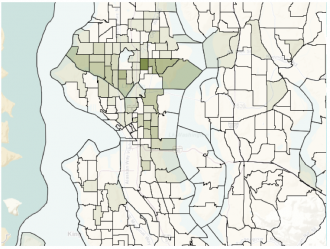
Bike commute numbers remained relatively unchanged in 2011 compared to 2010, according to newly released data from the Census Bureau’s annual American Communities Survey. The percentage of commuters choosing to bike came in at 3.5 percent,* one tenth of a percentage point less than in 2011 and well within the margin of error (actual number could be anywhere between 2.9 and 4 percent).
Though Seattle technically edges out San Francisco, the two cities are essentially tied for the #2 spot among large US cities (Portland is first, Minneapolis is a close fourth).
The new survey data appears to confirm the 22 percent gain in the cycling rate the survey found between 2009 and 2010, and represents a 71 percent growth in the raw number of people cycling to work in Seattle compared to 2005 (the mode share percentage grew by 33 percent). Meanwhile, bicycle-specific investments make up only 2 percent of the city’s transportation budget.
The percentage of people walking to work grew a stunning 24 percent since 2005 (though that number is particularly prone to shifts year-to-year and nearly reached 10 percent in 2008, but is now around 9 percent). Together, people who walk or bike to work make up more than 12 percent of daily commute trips.
The percentage of people biking to work in King County comes in at 1.5 percent, which is a similar decline to the Seattle numbers from 2010’s 1.6 percent and up from 2009’s 1.3 percent.
The percentage of people driving alone in Seattle has decreased by 6 percent since 2005, making up just 53.6 percent of commute trips. This even lower than Portland, where 57.8 percent of people drive alone to work. Interestingly, only 4.9 percent of people in Portland walk to work, half of the rate in Seattle and less than the 6.3 percent of people who bike to work there. So for those keeping score at home: A slightly higher percentage of people bike or walk to work in Seattle than Portland.
*There are several big caveats for dealing with this data. For one, the margins of error are fairly large, so it takes a big change year-to-year for the numbers to rise out of the static. Bike Portland also notes:
- Here’s how the question appears on the survey form: “How did this person usually get to work LAST WEEK? If this person usually used more than one method of transportation during the trip, mark (X) the box of the one used for most of the distance.” The respondent is also only allowed one answer. “So, if they drove a car 3 days of the week and biked or took transit 2 days,” local bicycle planning consultant Jessica Roberts explained to me once, “their answer would have to be driving their car.”
- Planners tell me that work trips account for only one of out eight bicycle trips. So, it’s a big mistake to think that only 6% of Portlanders ride bikes.
- Planners also feel that these U.S. Census number tend to under represent mode splits.
This question also seems to leave out the HUGE number of people who take their bikes on transit. King County was the first major transit system to include bike racks on buses (dating back to the early 90s), and thousands of people use the bike racks every day. So it’s safe to say that this number is an absolute lowest possible estimate of the use of bicycles in Seattle and should be treated as such.
If you want to flip through the data yourself, I made a Google Doc of the Seattle data from 2005-11.








Comments
7 responses to “Bike commute numbers unchanged in 2011 Census survey”
What percentage of the transportation budget goes to walking-specific investments?
My little piece of the annual bike-pedestrian count, at the corner of Westlake and Broad at the Cheshiahud trail between 7 and 9 am: 262 people on bikes, 264 walking. On the bikes, 189 men and 73 women; walking, 141 men and 123 women. I was surprised at the even split between walking and biking, and disappointed to see so few women on bikes compared to men. We won’t see the complete results for weeks; I have no idea if these numbers represent change.
I might as well be married, but I love me some female bikers. Can really make a fun ride into a pleasure ride. Heh.
I hope this goes without saying, but for me and for most of us female cyclists are part of our community, not a novelty to be leered at.
I would just like to point out that this map of where bicyclists live bears a more than passing resemblance to my alternative rollout plan for Bike Share in Seattle:
https://maps.google.com/maps/ms?msa=0&msid=217578783611843892504.0004c7630a07b85f75a5d
Yeah, let’s put our bike share away from major employment, retail, and tourist centers, and focus on residential neighborhoods that happen to have enough bike facilities that a larger-than-average minority of residents commute to their jobs on their own bicycles. Let’s furthermore use it to extend the enormous gap in bike infrastructure between north of the ship canal and every other part of Seattle. Let’s use money raised across the city by regressive sales taxes and fees to build a complacent Burke-Gilman Bike Share that benefits a small and, on average, relatively privileged part of the city.
Or, alternately, we could use it as a major part of transforming our urban core and waterfront, the place that all of us in this region share, into a place that’s more friendly for bikes.
If someone wants to build the former, well, they’re welcome to go into business and compete with the various seasonal bike rental places along the Burke, but I can’t see why any public money or endorsement should go to it. If someone wants to build the latter, let’s start yesterday.
Amen. Bike Share works best alongside other dense transportation networks and popular regional destinations. It’s meant to add bikes where there are not already bikes.